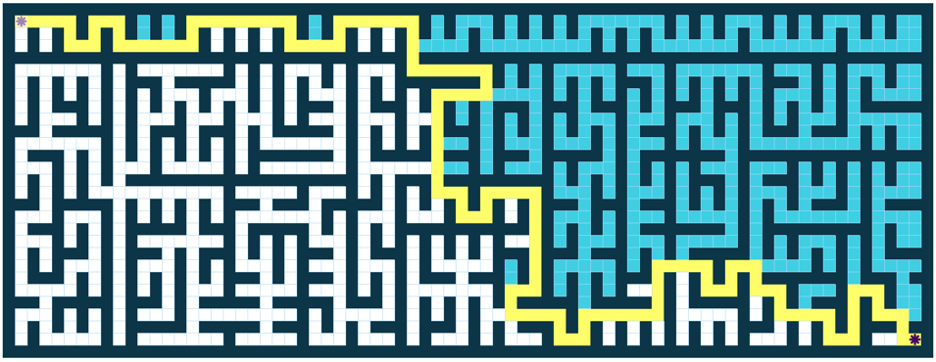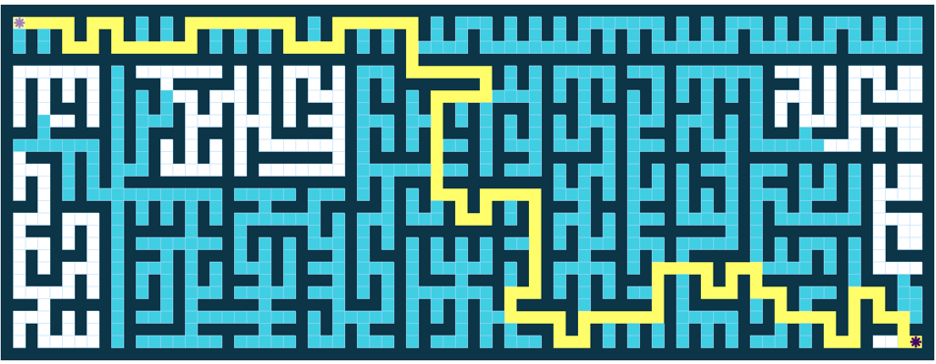In the intricate landscape of economic development, researchers, development practitioners, and policymakers share a common challenge: They know where the economy should go, but no one has a precise roadmap. Therefore, while they may agree on general principles, given ever-changing constraints across countries and time, disagreements on directions are never too far behind.
With such complications, the pursuit of economic development often resembles navigating a maze. One frequently encounters roadblocks and needs to retrace steps before making progress toward the destination. What is particularly intriguing is that prominent paradigms in the history of economic development appear to have parallels with maze-solving algorithms commonly employed in today’s machine-learning applications. This parallelism can be further exploited to put emerging economic development ideas into perspective. But we should first discuss how machines solve mazes.
Strategies for escaping a maze
Much like in economic development, agents navigating a maze do not know the maze’s overall design. Their objective is to reach the exit as quickly as possible by traversing the maze. To achieve this, they must carefully consider alternative decision-making rules. Although numerous solutions exist, machine-learning applications often favor one of two algorithms, the depth-first search (DFS) and breadth-first search (BFS):
- The DFS algorithm progresses along a path until it reaches either a dead end or a previously visited location. It then moves to an earlier junction and explores a different path, repeating this process until it discovers an exit. Figure 1 provides a pathfinding example, where DFS starts from the North-West corner and explores nearly half of the maze (blue shaded areas) to find the exit at the South-East corner. More precisely, for each cell on the shortest path (highlighted in yellow) DFS explores about 2.7 more cells.
- The BFS algorithm operates differently. It visits all locations in the order of their distance from the initial position. For example, it first explores cells 1 step away, retaining the information, then moves to cells 2 steps away and so on, expanding its frontier until it finds the exit. In Figure 2, this approach leaves much of the maze explored and 4.7 additional cells visited for each cell on the shortest path.
Both approaches have their strengths and limitations. While DFS can occasionally discover a fast path through luck, it may also squander valuable resources if it gets stuck. In addition, the path to the exit discovered by the DFS may or may not be the shortest one. By contrast, BFS guarantees that it will eventually find the shortest path to the exit, as it ventures out gradually in all possible directions. This is a valuable trait when that solution can be transferred to other problems that feature similar mazes. However, the actual cost of finding the exit for the first time under the BFS can be high, especially when it is distant. With these traits in mind, we next discuss how these two strategies can illustrate different historical approaches to development.
Figure 1. DFS visits 2.7 additional cells (blue) for each cell on the shortest path (yellow)

Figure 2. BFS visits 4.7 additional cells (blue) for each cell on the shortest path (yellow)

Paradigms of economic development as maze-solving strategies
Early approaches to economic development followed a DFS-like vision by primarily focusing on capital. Both policymakers, including those in communist countries, and the leading development organization, the World Bank, believed that if a country was poor, it was because it lacked capital—both financial and physical. The results of this obsessions with capital, however, fell short of expectations: Without the right skills, physical capital could not be utilized properly, and without the right institutional setup, investments could not be scaled up sufficiently.
Soon, a multipronged approach to development, one that is reminiscent of the BFS strategy, became the mainstream paradigm. The “Basic Needs Approach” of the 1970s, the U.N.’s Human Development Index in the 1990s, and James D. Wolfensohn’s “Comprehensive Development Framework” in the 2000s broadened the scope of development policies to include education, health, water and sanitation, and governance. As with the BFS approach, however, progress under this comprehensive approach has been relatively slow, with many countries, especially those in Africa, not yet catching up with more advanced economies.
The search for more rapid development occasionally leads to DFS-like flare-ups. Some parties have recently proposed moonshot approaches to promote digital development or address climate/environment challenges. Some countries, including many in Africa, have harked back to capital-oriented approaches, sometimes borrowing on non-concessional terms to invest heavily in their infrastructure. Unfortunately, without accompanying reforms, several of those countries are facing debt distress after their investments have failed to accelerate growth before debt service obligations piled up.
In the shadows of such DFS-BFS oscillations, the elements of a new approach have been brewing. Although not yet a coherent strategy, this emerging approach, when ready, has the potential to resolve the DFS-BFS dichotomy not by overhauling the development architecture, but by introducing a few crucial refinements. Once again, invoking machine learning can help formulate this.
Toward a new paradigm?
A third category of maze-solving strategies, one that refines the approaches of DFS and BFS, is known as best-first search (BeFS). In contrast to the previous two strategies, which blindly follow a path without assessing its properties in regard to the exit, the BeFS evaluates information it gathers from each move (in technical terms, a “heuristic”). This information is typically a metric denoting the current distance to the exit, e.g., Euclidean distance in economics and Manhattan distance in machine learning. This is like using the GPS coordinates of a known destination and the current position for driving on an unknown network of roads. At decision points, BeFS selects the step that brings it closer to the exit based on this heuristic. In Figure 3, this strategy successfully reaches the exit quickly, visiting only 0.4 more cells for each cell on the shortest path.
Fig. 3. BeFS visits 0.4 additional cells (blue) for each cell on the shortest path (yellow)

Interestingly, this strategy is also helpful for a better understanding of emerging ideas in economic development. For example, BeFS’s distinctive focus on information (distance) and achieving results with each step (reducing distance) find parallels among economic development scholars and practitioners, as outlined below:
- From a technical standpoint, development economics has increasingly focused on evaluating the impact of policy interventions in recent years. This often occurs at a micro scale and relies on methods such as randomized controlled trials (RCT) and other experimental approaches. The evidence base generated by these efforts can be instrumental in promoting the adoption of a heuristic even when we lack a comprehensive understanding of the entire development landscape.
- On the policy front, the new president of the World Bank, Ajay Banga, is advocating the use of results such as increased labor force participation and improved access to clean water as guideposts for development assistance, even in the short term. This “impact as the new measuring stick” approach is akin to a BeFS heuristic. While Mr. Banga’s emphasis on the role of the private sector in this context is often perceived in financial terms, the BeFS analogy suggests that leveraging the sector’s intimate knowledge of the economy could further enhance potential heuristics.
Overall, the BeFS analogy helps us better appreciate the complementary nature of the academic focus on evaluation and policy emphasis on results-based development assistance. It also illustrates that if these complementary trends evolve into a comprehensive strategy like the BeFS, they may constitute a more radical departure from earlier approaches than initially apparent.
Perhaps more importantly, the BeFS analogy is also useful for analyzing potential pitfalls ahead. Like other strategies, the BeFS carries inherent vulnerabilities. It is inevitably sensitive to flawed heuristics and can yield inferior results in specific circumstances (e.g., a maze that favors indirect approaches), which can exploit these weaknesses. Therefore, fixating on a narrow set of indicators can be catastrophic. To avoid this, significant investments should be made to build on the information base and to continuously design country-specific heuristics. As Goodhart’s Law aptly states, when a measure becomes a target, it ceases to be a good measure.
The Brookings Institution is committed to quality, independence, and impact.
We are supported by a diverse array of funders. In line with our values and policies, each Brookings publication represents the sole views of its author(s).





Commentary
Economic development as a maze-solving problem
October 12, 2023